BX2174 Research Proposal: Economic Integration, FDI, & Business Impact
VerifiedAdded on 2023/04/21
|10
|2107
|299
Report
AI Summary
This research proposal investigates the relationship between regional economic integration and Foreign Direct Investment (FDI) and its impact on Singaporean business subsidiaries. The study employs a mixed-methods approach, utilizing secondary data and primary data collected through questionnaire surveys of employees in top multinational corporations (MNCs). The research aims to determine whether the relationship between regional economic integration and FDI positively or negatively affects Singaporean business subsidiaries, with hypotheses formulated to guide the investigation. The proposal outlines the research context, question, design, methods, key variables, sampling strategy, and ethical considerations. Ultimately, the research seeks to provide insights into the interconnectedness of economic integration, FDI, and business development in rapidly developing nations like Singapore. Desklib provides a platform to access similar research papers and solved assignments.
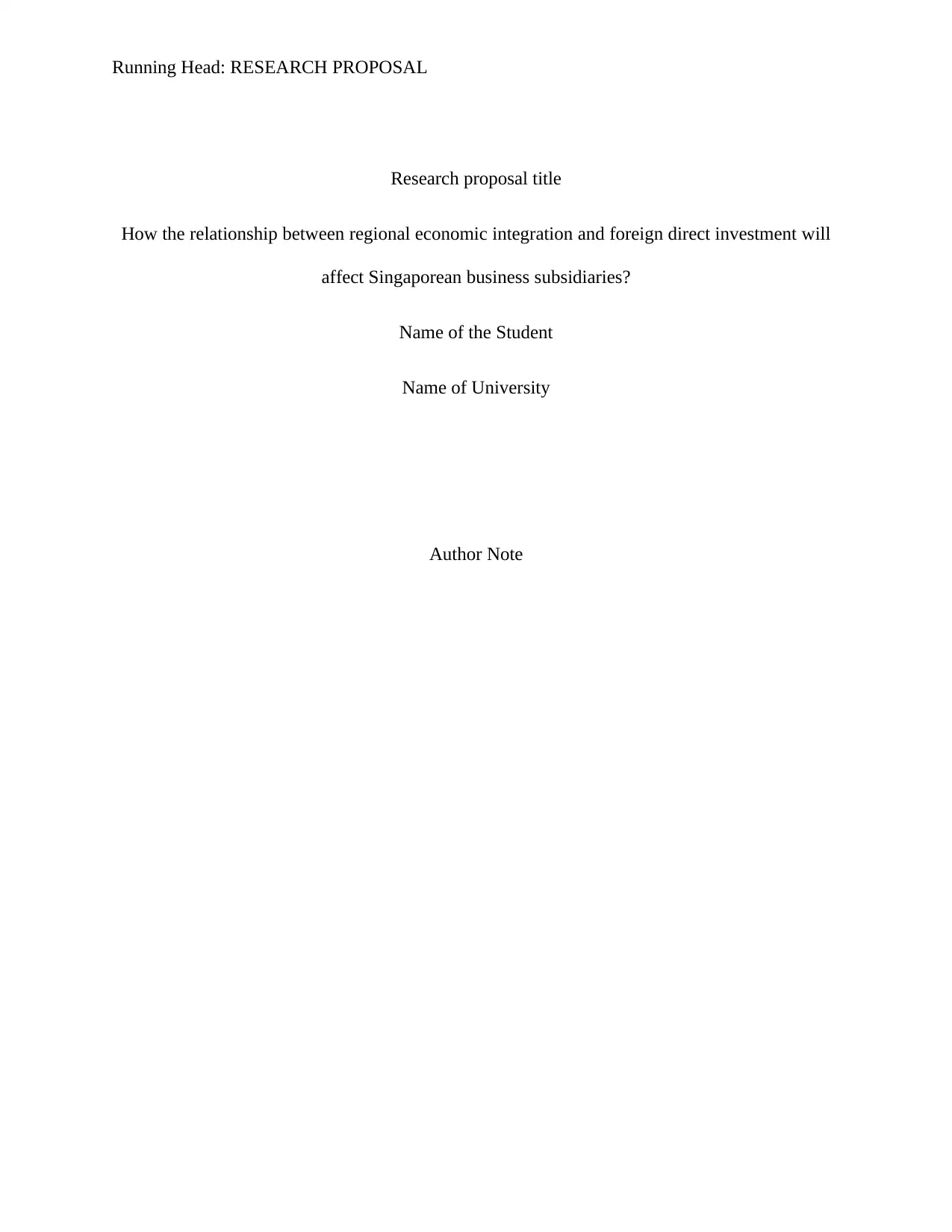
Running Head: RESEARCH PROPOSAL
Research proposal title
How the relationship between regional economic integration and foreign direct investment will
affect Singaporean business subsidiaries?
Name of the Student
Name of University
Author Note
Research proposal title
How the relationship between regional economic integration and foreign direct investment will
affect Singaporean business subsidiaries?
Name of the Student
Name of University
Author Note
Paraphrase This Document
Need a fresh take? Get an instant paraphrase of this document with our AI Paraphraser
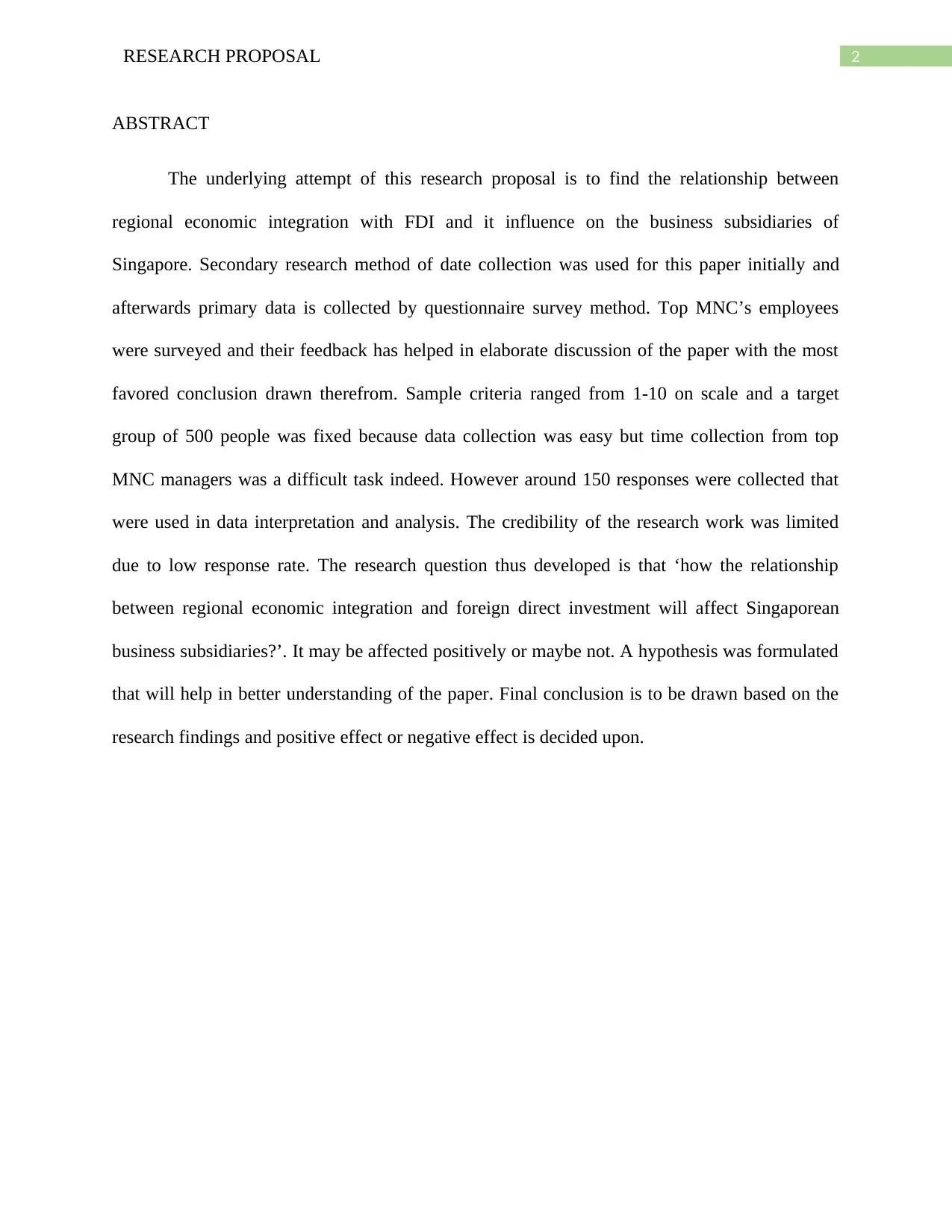
2RESEARCH PROPOSAL
ABSTRACT
The underlying attempt of this research proposal is to find the relationship between
regional economic integration with FDI and it influence on the business subsidiaries of
Singapore. Secondary research method of date collection was used for this paper initially and
afterwards primary data is collected by questionnaire survey method. Top MNC’s employees
were surveyed and their feedback has helped in elaborate discussion of the paper with the most
favored conclusion drawn therefrom. Sample criteria ranged from 1-10 on scale and a target
group of 500 people was fixed because data collection was easy but time collection from top
MNC managers was a difficult task indeed. However around 150 responses were collected that
were used in data interpretation and analysis. The credibility of the research work was limited
due to low response rate. The research question thus developed is that ‘how the relationship
between regional economic integration and foreign direct investment will affect Singaporean
business subsidiaries?’. It may be affected positively or maybe not. A hypothesis was formulated
that will help in better understanding of the paper. Final conclusion is to be drawn based on the
research findings and positive effect or negative effect is decided upon.
ABSTRACT
The underlying attempt of this research proposal is to find the relationship between
regional economic integration with FDI and it influence on the business subsidiaries of
Singapore. Secondary research method of date collection was used for this paper initially and
afterwards primary data is collected by questionnaire survey method. Top MNC’s employees
were surveyed and their feedback has helped in elaborate discussion of the paper with the most
favored conclusion drawn therefrom. Sample criteria ranged from 1-10 on scale and a target
group of 500 people was fixed because data collection was easy but time collection from top
MNC managers was a difficult task indeed. However around 150 responses were collected that
were used in data interpretation and analysis. The credibility of the research work was limited
due to low response rate. The research question thus developed is that ‘how the relationship
between regional economic integration and foreign direct investment will affect Singaporean
business subsidiaries?’. It may be affected positively or maybe not. A hypothesis was formulated
that will help in better understanding of the paper. Final conclusion is to be drawn based on the
research findings and positive effect or negative effect is decided upon.
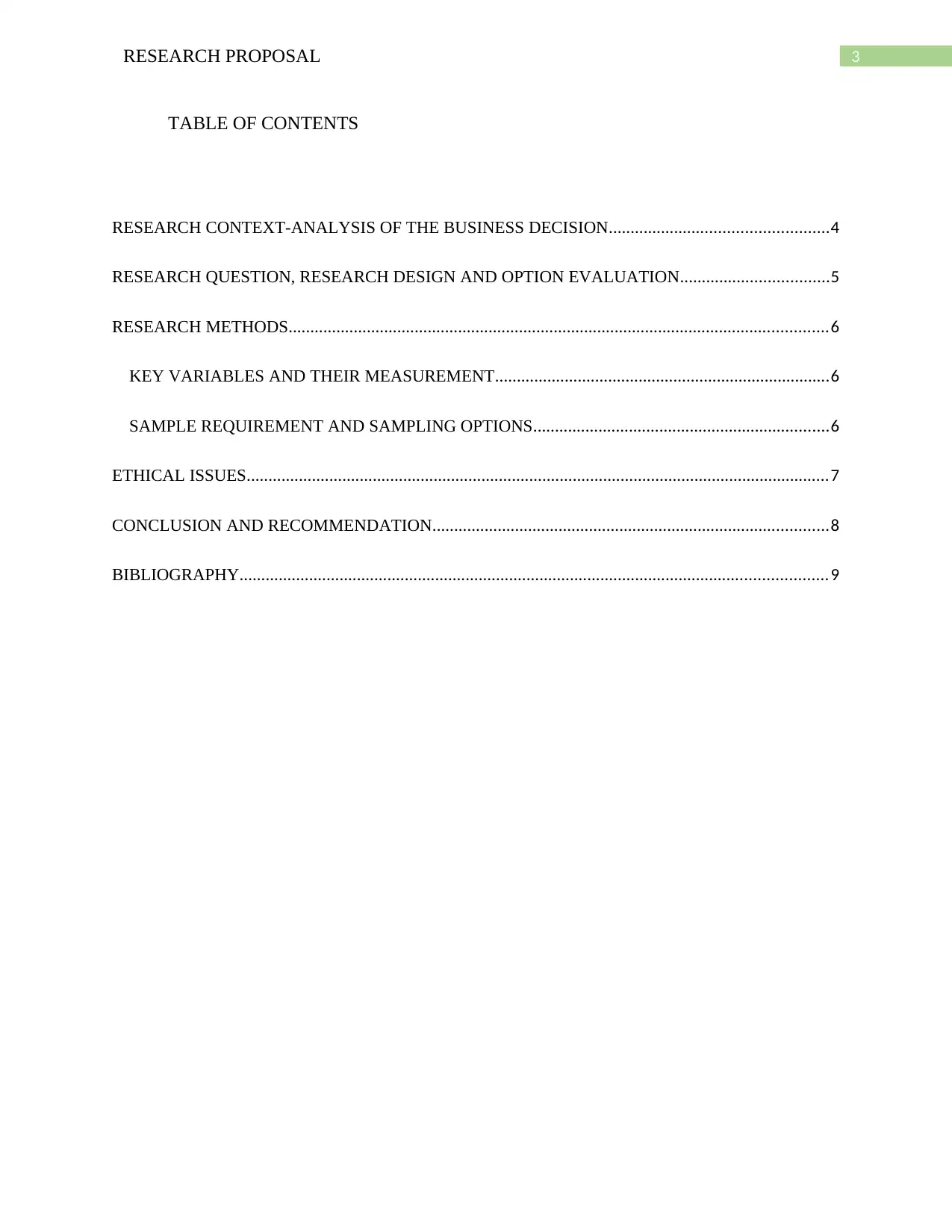
3RESEARCH PROPOSAL
TABLE OF CONTENTS
RESEARCH CONTEXT-ANALYSIS OF THE BUSINESS DECISION..................................................4
RESEARCH QUESTION, RESEARCH DESIGN AND OPTION EVALUATION..................................5
RESEARCH METHODS............................................................................................................................6
KEY VARIABLES AND THEIR MEASUREMENT.............................................................................6
SAMPLE REQUIREMENT AND SAMPLING OPTIONS....................................................................6
ETHICAL ISSUES......................................................................................................................................7
CONCLUSION AND RECOMMENDATION...........................................................................................8
BIBLIOGRAPHY.......................................................................................................................................9
TABLE OF CONTENTS
RESEARCH CONTEXT-ANALYSIS OF THE BUSINESS DECISION..................................................4
RESEARCH QUESTION, RESEARCH DESIGN AND OPTION EVALUATION..................................5
RESEARCH METHODS............................................................................................................................6
KEY VARIABLES AND THEIR MEASUREMENT.............................................................................6
SAMPLE REQUIREMENT AND SAMPLING OPTIONS....................................................................6
ETHICAL ISSUES......................................................................................................................................7
CONCLUSION AND RECOMMENDATION...........................................................................................8
BIBLIOGRAPHY.......................................................................................................................................9
⊘ This is a preview!⊘
Do you want full access?
Subscribe today to unlock all pages.

Trusted by 1+ million students worldwide
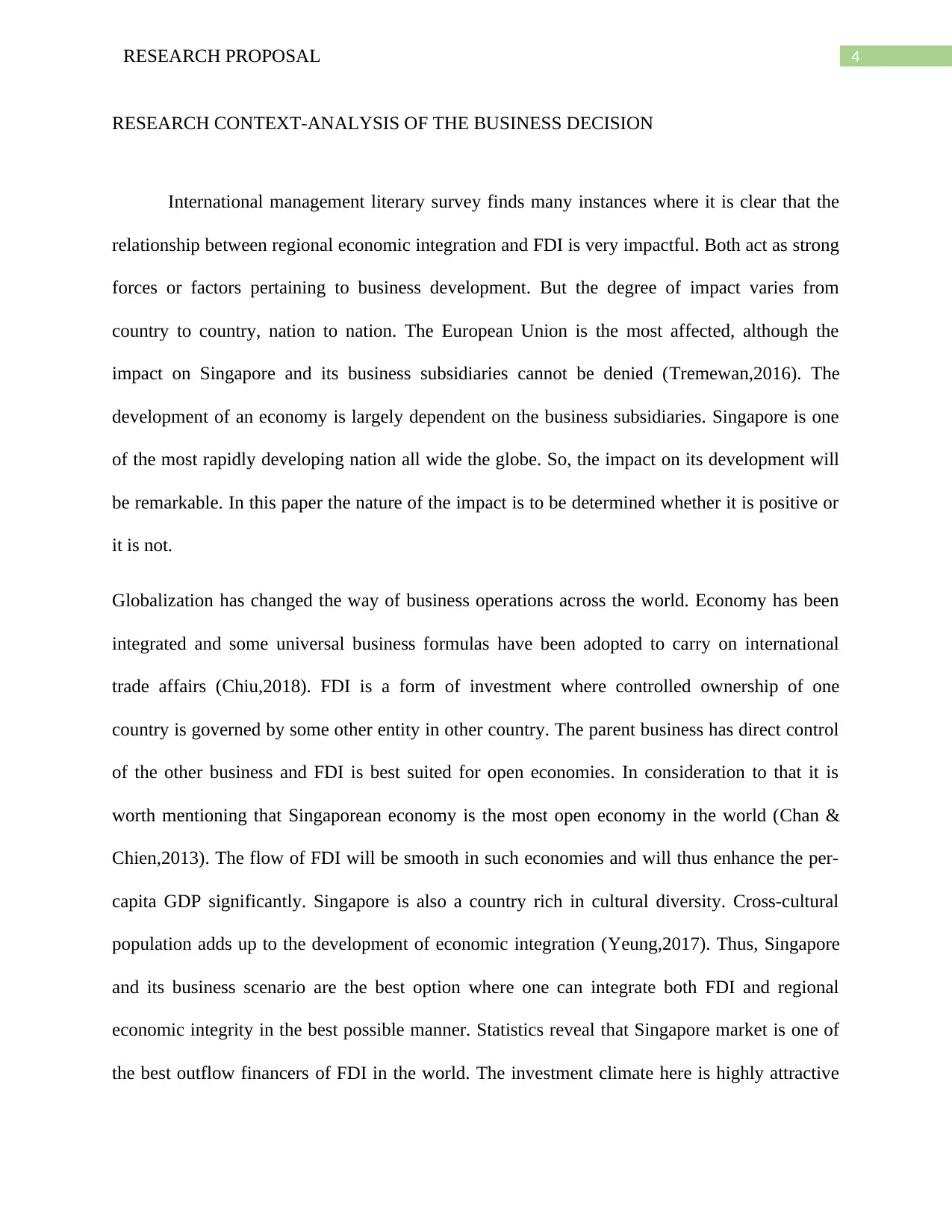
4RESEARCH PROPOSAL
RESEARCH CONTEXT-ANALYSIS OF THE BUSINESS DECISION
International management literary survey finds many instances where it is clear that the
relationship between regional economic integration and FDI is very impactful. Both act as strong
forces or factors pertaining to business development. But the degree of impact varies from
country to country, nation to nation. The European Union is the most affected, although the
impact on Singapore and its business subsidiaries cannot be denied (Tremewan,2016). The
development of an economy is largely dependent on the business subsidiaries. Singapore is one
of the most rapidly developing nation all wide the globe. So, the impact on its development will
be remarkable. In this paper the nature of the impact is to be determined whether it is positive or
it is not.
Globalization has changed the way of business operations across the world. Economy has been
integrated and some universal business formulas have been adopted to carry on international
trade affairs (Chiu,2018). FDI is a form of investment where controlled ownership of one
country is governed by some other entity in other country. The parent business has direct control
of the other business and FDI is best suited for open economies. In consideration to that it is
worth mentioning that Singaporean economy is the most open economy in the world (Chan &
Chien,2013). The flow of FDI will be smooth in such economies and will thus enhance the per-
capita GDP significantly. Singapore is also a country rich in cultural diversity. Cross-cultural
population adds up to the development of economic integration (Yeung,2017). Thus, Singapore
and its business scenario are the best option where one can integrate both FDI and regional
economic integrity in the best possible manner. Statistics reveal that Singapore market is one of
the best outflow financers of FDI in the world. The investment climate here is highly attractive
RESEARCH CONTEXT-ANALYSIS OF THE BUSINESS DECISION
International management literary survey finds many instances where it is clear that the
relationship between regional economic integration and FDI is very impactful. Both act as strong
forces or factors pertaining to business development. But the degree of impact varies from
country to country, nation to nation. The European Union is the most affected, although the
impact on Singapore and its business subsidiaries cannot be denied (Tremewan,2016). The
development of an economy is largely dependent on the business subsidiaries. Singapore is one
of the most rapidly developing nation all wide the globe. So, the impact on its development will
be remarkable. In this paper the nature of the impact is to be determined whether it is positive or
it is not.
Globalization has changed the way of business operations across the world. Economy has been
integrated and some universal business formulas have been adopted to carry on international
trade affairs (Chiu,2018). FDI is a form of investment where controlled ownership of one
country is governed by some other entity in other country. The parent business has direct control
of the other business and FDI is best suited for open economies. In consideration to that it is
worth mentioning that Singaporean economy is the most open economy in the world (Chan &
Chien,2013). The flow of FDI will be smooth in such economies and will thus enhance the per-
capita GDP significantly. Singapore is also a country rich in cultural diversity. Cross-cultural
population adds up to the development of economic integration (Yeung,2017). Thus, Singapore
and its business scenario are the best option where one can integrate both FDI and regional
economic integrity in the best possible manner. Statistics reveal that Singapore market is one of
the best outflow financers of FDI in the world. The investment climate here is highly attractive
Paraphrase This Document
Need a fresh take? Get an instant paraphrase of this document with our AI Paraphraser
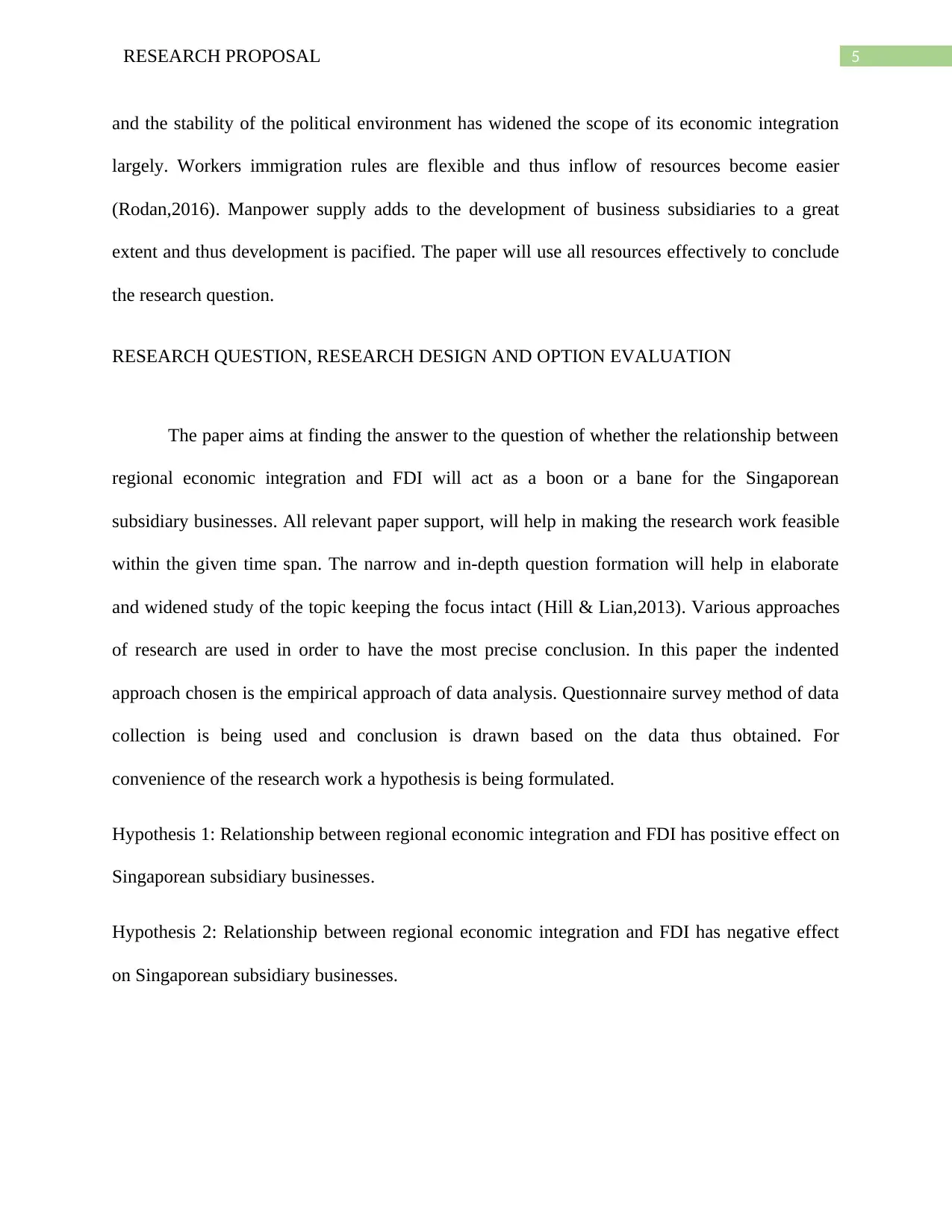
5RESEARCH PROPOSAL
and the stability of the political environment has widened the scope of its economic integration
largely. Workers immigration rules are flexible and thus inflow of resources become easier
(Rodan,2016). Manpower supply adds to the development of business subsidiaries to a great
extent and thus development is pacified. The paper will use all resources effectively to conclude
the research question.
RESEARCH QUESTION, RESEARCH DESIGN AND OPTION EVALUATION
The paper aims at finding the answer to the question of whether the relationship between
regional economic integration and FDI will act as a boon or a bane for the Singaporean
subsidiary businesses. All relevant paper support, will help in making the research work feasible
within the given time span. The narrow and in-depth question formation will help in elaborate
and widened study of the topic keeping the focus intact (Hill & Lian,2013). Various approaches
of research are used in order to have the most precise conclusion. In this paper the indented
approach chosen is the empirical approach of data analysis. Questionnaire survey method of data
collection is being used and conclusion is drawn based on the data thus obtained. For
convenience of the research work a hypothesis is being formulated.
Hypothesis 1: Relationship between regional economic integration and FDI has positive effect on
Singaporean subsidiary businesses.
Hypothesis 2: Relationship between regional economic integration and FDI has negative effect
on Singaporean subsidiary businesses.
and the stability of the political environment has widened the scope of its economic integration
largely. Workers immigration rules are flexible and thus inflow of resources become easier
(Rodan,2016). Manpower supply adds to the development of business subsidiaries to a great
extent and thus development is pacified. The paper will use all resources effectively to conclude
the research question.
RESEARCH QUESTION, RESEARCH DESIGN AND OPTION EVALUATION
The paper aims at finding the answer to the question of whether the relationship between
regional economic integration and FDI will act as a boon or a bane for the Singaporean
subsidiary businesses. All relevant paper support, will help in making the research work feasible
within the given time span. The narrow and in-depth question formation will help in elaborate
and widened study of the topic keeping the focus intact (Hill & Lian,2013). Various approaches
of research are used in order to have the most precise conclusion. In this paper the indented
approach chosen is the empirical approach of data analysis. Questionnaire survey method of data
collection is being used and conclusion is drawn based on the data thus obtained. For
convenience of the research work a hypothesis is being formulated.
Hypothesis 1: Relationship between regional economic integration and FDI has positive effect on
Singaporean subsidiary businesses.
Hypothesis 2: Relationship between regional economic integration and FDI has negative effect
on Singaporean subsidiary businesses.
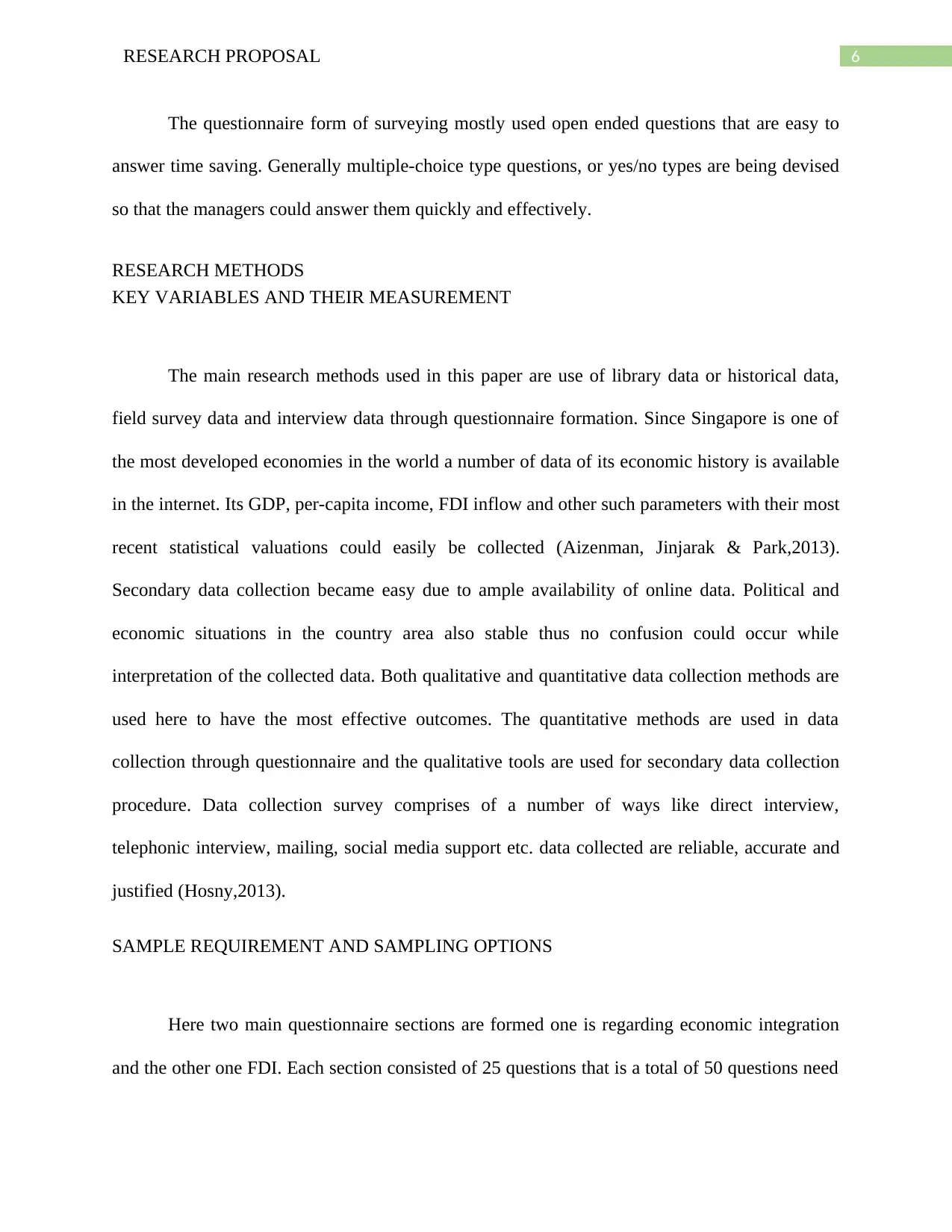
6RESEARCH PROPOSAL
The questionnaire form of surveying mostly used open ended questions that are easy to
answer time saving. Generally multiple-choice type questions, or yes/no types are being devised
so that the managers could answer them quickly and effectively.
RESEARCH METHODS
KEY VARIABLES AND THEIR MEASUREMENT
The main research methods used in this paper are use of library data or historical data,
field survey data and interview data through questionnaire formation. Since Singapore is one of
the most developed economies in the world a number of data of its economic history is available
in the internet. Its GDP, per-capita income, FDI inflow and other such parameters with their most
recent statistical valuations could easily be collected (Aizenman, Jinjarak & Park,2013).
Secondary data collection became easy due to ample availability of online data. Political and
economic situations in the country area also stable thus no confusion could occur while
interpretation of the collected data. Both qualitative and quantitative data collection methods are
used here to have the most effective outcomes. The quantitative methods are used in data
collection through questionnaire and the qualitative tools are used for secondary data collection
procedure. Data collection survey comprises of a number of ways like direct interview,
telephonic interview, mailing, social media support etc. data collected are reliable, accurate and
justified (Hosny,2013).
SAMPLE REQUIREMENT AND SAMPLING OPTIONS
Here two main questionnaire sections are formed one is regarding economic integration
and the other one FDI. Each section consisted of 25 questions that is a total of 50 questions need
The questionnaire form of surveying mostly used open ended questions that are easy to
answer time saving. Generally multiple-choice type questions, or yes/no types are being devised
so that the managers could answer them quickly and effectively.
RESEARCH METHODS
KEY VARIABLES AND THEIR MEASUREMENT
The main research methods used in this paper are use of library data or historical data,
field survey data and interview data through questionnaire formation. Since Singapore is one of
the most developed economies in the world a number of data of its economic history is available
in the internet. Its GDP, per-capita income, FDI inflow and other such parameters with their most
recent statistical valuations could easily be collected (Aizenman, Jinjarak & Park,2013).
Secondary data collection became easy due to ample availability of online data. Political and
economic situations in the country area also stable thus no confusion could occur while
interpretation of the collected data. Both qualitative and quantitative data collection methods are
used here to have the most effective outcomes. The quantitative methods are used in data
collection through questionnaire and the qualitative tools are used for secondary data collection
procedure. Data collection survey comprises of a number of ways like direct interview,
telephonic interview, mailing, social media support etc. data collected are reliable, accurate and
justified (Hosny,2013).
SAMPLE REQUIREMENT AND SAMPLING OPTIONS
Here two main questionnaire sections are formed one is regarding economic integration
and the other one FDI. Each section consisted of 25 questions that is a total of 50 questions need
⊘ This is a preview!⊘
Do you want full access?
Subscribe today to unlock all pages.

Trusted by 1+ million students worldwide
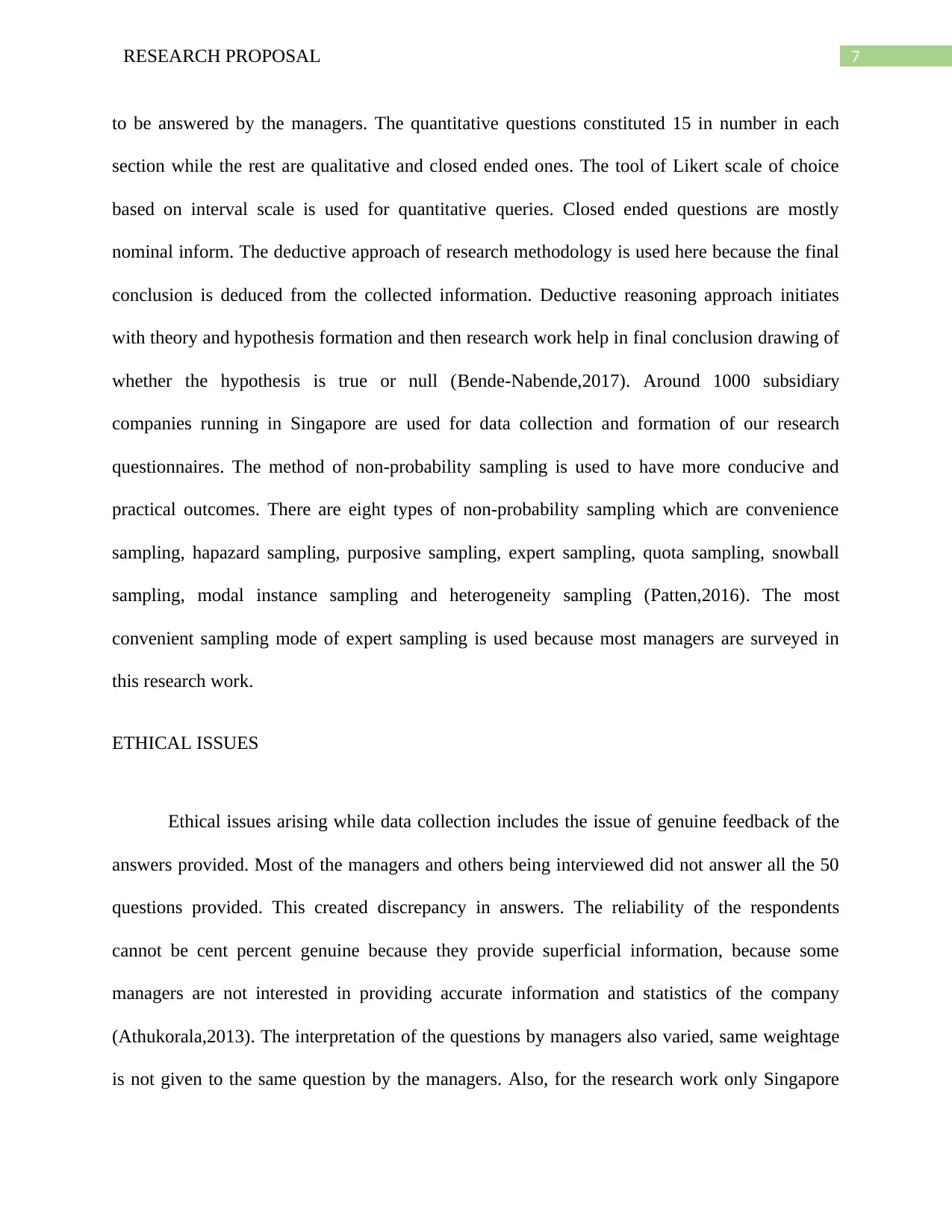
7RESEARCH PROPOSAL
to be answered by the managers. The quantitative questions constituted 15 in number in each
section while the rest are qualitative and closed ended ones. The tool of Likert scale of choice
based on interval scale is used for quantitative queries. Closed ended questions are mostly
nominal inform. The deductive approach of research methodology is used here because the final
conclusion is deduced from the collected information. Deductive reasoning approach initiates
with theory and hypothesis formation and then research work help in final conclusion drawing of
whether the hypothesis is true or null (Bende-Nabende,2017). Around 1000 subsidiary
companies running in Singapore are used for data collection and formation of our research
questionnaires. The method of non-probability sampling is used to have more conducive and
practical outcomes. There are eight types of non-probability sampling which are convenience
sampling, hapazard sampling, purposive sampling, expert sampling, quota sampling, snowball
sampling, modal instance sampling and heterogeneity sampling (Patten,2016). The most
convenient sampling mode of expert sampling is used because most managers are surveyed in
this research work.
ETHICAL ISSUES
Ethical issues arising while data collection includes the issue of genuine feedback of the
answers provided. Most of the managers and others being interviewed did not answer all the 50
questions provided. This created discrepancy in answers. The reliability of the respondents
cannot be cent percent genuine because they provide superficial information, because some
managers are not interested in providing accurate information and statistics of the company
(Athukorala,2013). The interpretation of the questions by managers also varied, same weightage
is not given to the same question by the managers. Also, for the research work only Singapore
to be answered by the managers. The quantitative questions constituted 15 in number in each
section while the rest are qualitative and closed ended ones. The tool of Likert scale of choice
based on interval scale is used for quantitative queries. Closed ended questions are mostly
nominal inform. The deductive approach of research methodology is used here because the final
conclusion is deduced from the collected information. Deductive reasoning approach initiates
with theory and hypothesis formation and then research work help in final conclusion drawing of
whether the hypothesis is true or null (Bende-Nabende,2017). Around 1000 subsidiary
companies running in Singapore are used for data collection and formation of our research
questionnaires. The method of non-probability sampling is used to have more conducive and
practical outcomes. There are eight types of non-probability sampling which are convenience
sampling, hapazard sampling, purposive sampling, expert sampling, quota sampling, snowball
sampling, modal instance sampling and heterogeneity sampling (Patten,2016). The most
convenient sampling mode of expert sampling is used because most managers are surveyed in
this research work.
ETHICAL ISSUES
Ethical issues arising while data collection includes the issue of genuine feedback of the
answers provided. Most of the managers and others being interviewed did not answer all the 50
questions provided. This created discrepancy in answers. The reliability of the respondents
cannot be cent percent genuine because they provide superficial information, because some
managers are not interested in providing accurate information and statistics of the company
(Athukorala,2013). The interpretation of the questions by managers also varied, same weightage
is not given to the same question by the managers. Also, for the research work only Singapore
Paraphrase This Document
Need a fresh take? Get an instant paraphrase of this document with our AI Paraphraser
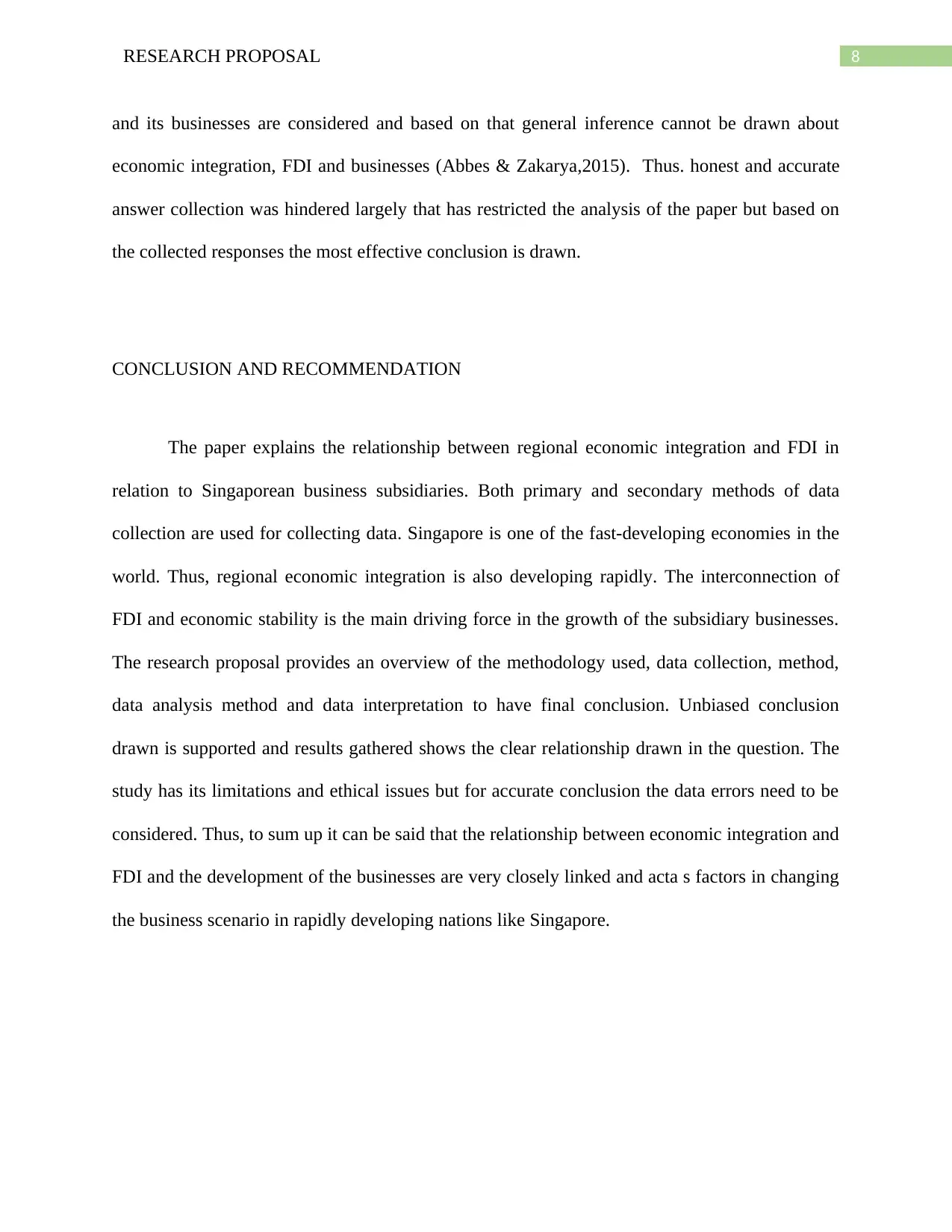
8RESEARCH PROPOSAL
and its businesses are considered and based on that general inference cannot be drawn about
economic integration, FDI and businesses (Abbes & Zakarya,2015). Thus. honest and accurate
answer collection was hindered largely that has restricted the analysis of the paper but based on
the collected responses the most effective conclusion is drawn.
CONCLUSION AND RECOMMENDATION
The paper explains the relationship between regional economic integration and FDI in
relation to Singaporean business subsidiaries. Both primary and secondary methods of data
collection are used for collecting data. Singapore is one of the fast-developing economies in the
world. Thus, regional economic integration is also developing rapidly. The interconnection of
FDI and economic stability is the main driving force in the growth of the subsidiary businesses.
The research proposal provides an overview of the methodology used, data collection, method,
data analysis method and data interpretation to have final conclusion. Unbiased conclusion
drawn is supported and results gathered shows the clear relationship drawn in the question. The
study has its limitations and ethical issues but for accurate conclusion the data errors need to be
considered. Thus, to sum up it can be said that the relationship between economic integration and
FDI and the development of the businesses are very closely linked and acta s factors in changing
the business scenario in rapidly developing nations like Singapore.
and its businesses are considered and based on that general inference cannot be drawn about
economic integration, FDI and businesses (Abbes & Zakarya,2015). Thus. honest and accurate
answer collection was hindered largely that has restricted the analysis of the paper but based on
the collected responses the most effective conclusion is drawn.
CONCLUSION AND RECOMMENDATION
The paper explains the relationship between regional economic integration and FDI in
relation to Singaporean business subsidiaries. Both primary and secondary methods of data
collection are used for collecting data. Singapore is one of the fast-developing economies in the
world. Thus, regional economic integration is also developing rapidly. The interconnection of
FDI and economic stability is the main driving force in the growth of the subsidiary businesses.
The research proposal provides an overview of the methodology used, data collection, method,
data analysis method and data interpretation to have final conclusion. Unbiased conclusion
drawn is supported and results gathered shows the clear relationship drawn in the question. The
study has its limitations and ethical issues but for accurate conclusion the data errors need to be
considered. Thus, to sum up it can be said that the relationship between economic integration and
FDI and the development of the businesses are very closely linked and acta s factors in changing
the business scenario in rapidly developing nations like Singapore.
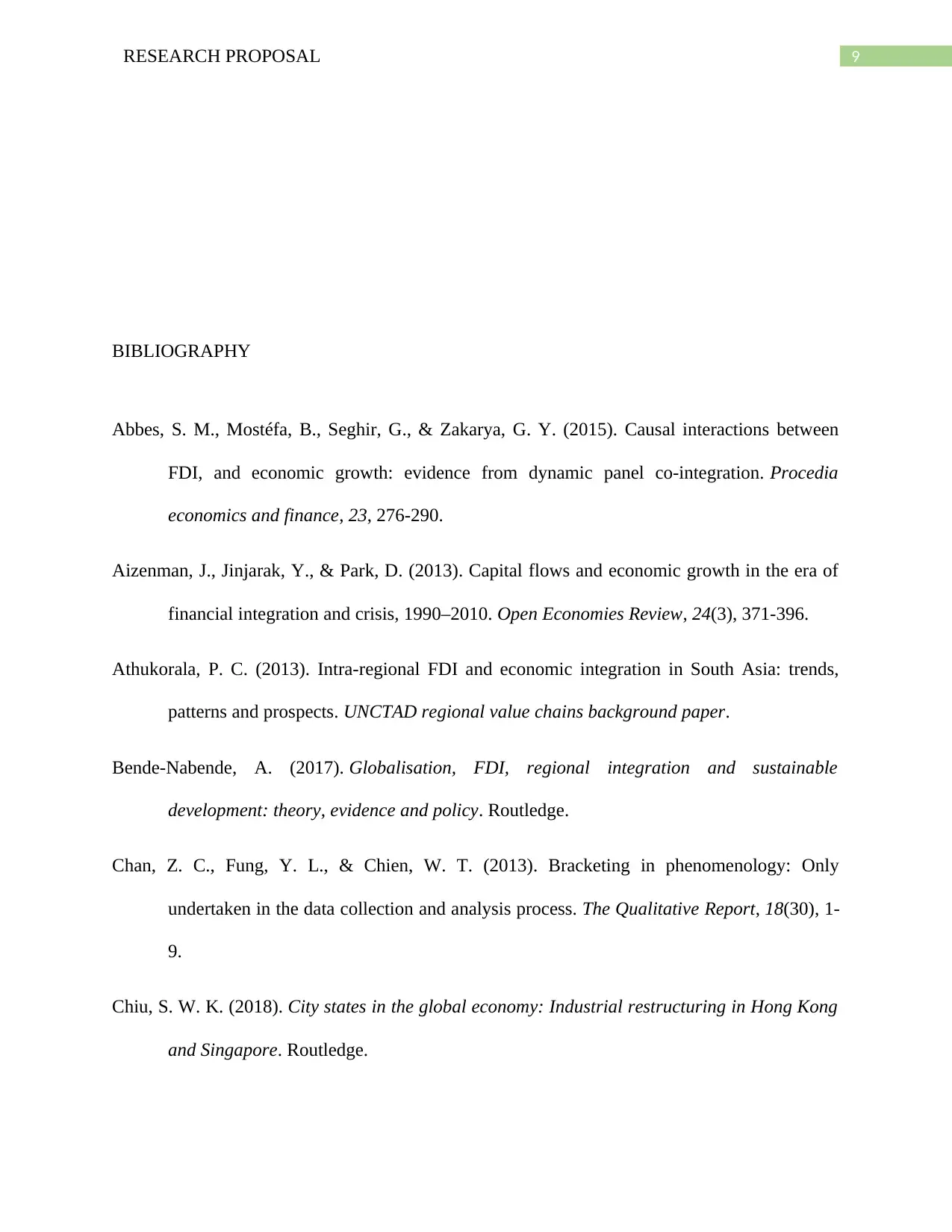
9RESEARCH PROPOSAL
BIBLIOGRAPHY
Abbes, S. M., Mostéfa, B., Seghir, G., & Zakarya, G. Y. (2015). Causal interactions between
FDI, and economic growth: evidence from dynamic panel co-integration. Procedia
economics and finance, 23, 276-290.
Aizenman, J., Jinjarak, Y., & Park, D. (2013). Capital flows and economic growth in the era of
financial integration and crisis, 1990–2010. Open Economies Review, 24(3), 371-396.
Athukorala, P. C. (2013). Intra-regional FDI and economic integration in South Asia: trends,
patterns and prospects. UNCTAD regional value chains background paper.
Bende-Nabende, A. (2017). Globalisation, FDI, regional integration and sustainable
development: theory, evidence and policy. Routledge.
Chan, Z. C., Fung, Y. L., & Chien, W. T. (2013). Bracketing in phenomenology: Only
undertaken in the data collection and analysis process. The Qualitative Report, 18(30), 1-
9.
Chiu, S. W. K. (2018). City states in the global economy: Industrial restructuring in Hong Kong
and Singapore. Routledge.
BIBLIOGRAPHY
Abbes, S. M., Mostéfa, B., Seghir, G., & Zakarya, G. Y. (2015). Causal interactions between
FDI, and economic growth: evidence from dynamic panel co-integration. Procedia
economics and finance, 23, 276-290.
Aizenman, J., Jinjarak, Y., & Park, D. (2013). Capital flows and economic growth in the era of
financial integration and crisis, 1990–2010. Open Economies Review, 24(3), 371-396.
Athukorala, P. C. (2013). Intra-regional FDI and economic integration in South Asia: trends,
patterns and prospects. UNCTAD regional value chains background paper.
Bende-Nabende, A. (2017). Globalisation, FDI, regional integration and sustainable
development: theory, evidence and policy. Routledge.
Chan, Z. C., Fung, Y. L., & Chien, W. T. (2013). Bracketing in phenomenology: Only
undertaken in the data collection and analysis process. The Qualitative Report, 18(30), 1-
9.
Chiu, S. W. K. (2018). City states in the global economy: Industrial restructuring in Hong Kong
and Singapore. Routledge.
⊘ This is a preview!⊘
Do you want full access?
Subscribe today to unlock all pages.

Trusted by 1+ million students worldwide
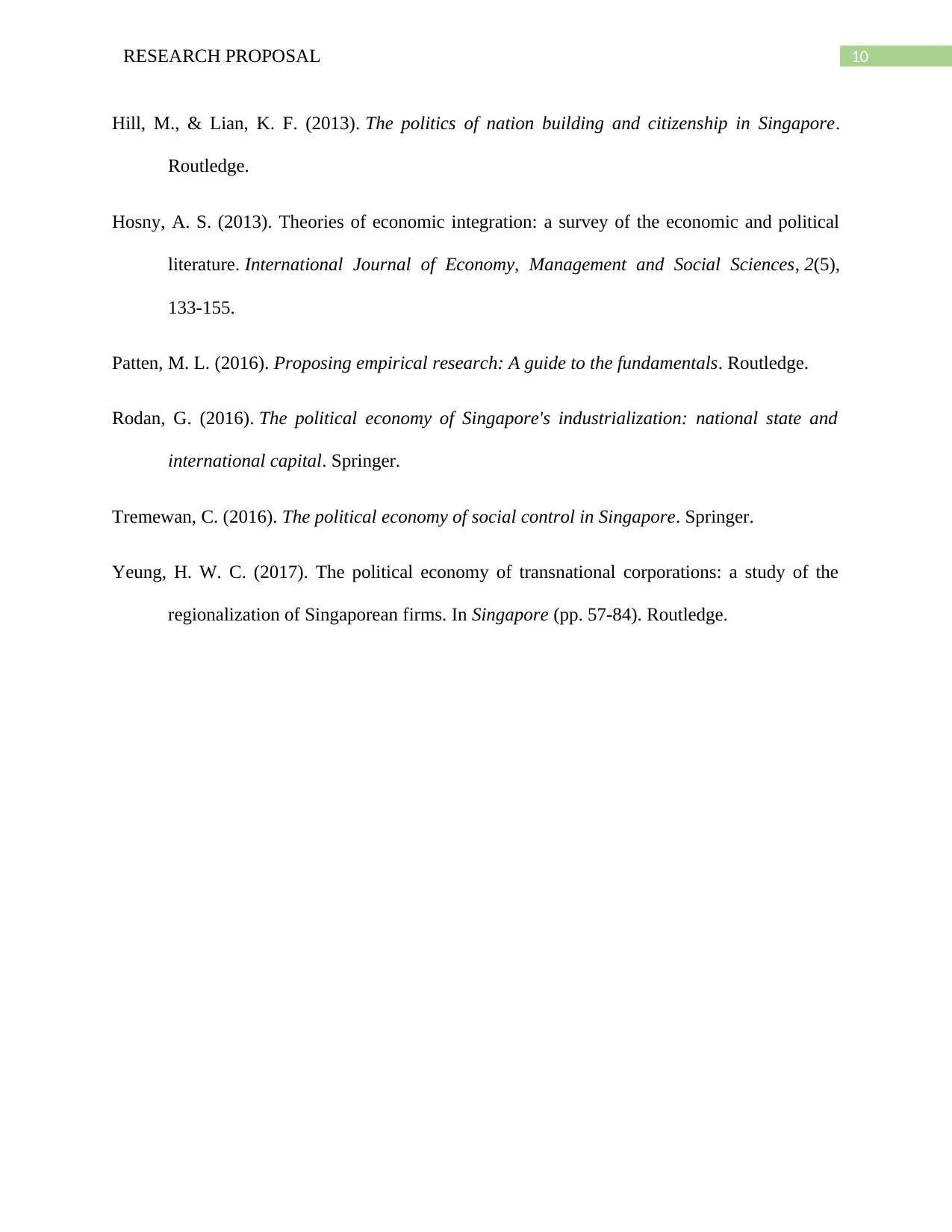
10RESEARCH PROPOSAL
Hill, M., & Lian, K. F. (2013). The politics of nation building and citizenship in Singapore.
Routledge.
Hosny, A. S. (2013). Theories of economic integration: a survey of the economic and political
literature. International Journal of Economy, Management and Social Sciences, 2(5),
133-155.
Patten, M. L. (2016). Proposing empirical research: A guide to the fundamentals. Routledge.
Rodan, G. (2016). The political economy of Singapore's industrialization: national state and
international capital. Springer.
Tremewan, C. (2016). The political economy of social control in Singapore. Springer.
Yeung, H. W. C. (2017). The political economy of transnational corporations: a study of the
regionalization of Singaporean firms. In Singapore (pp. 57-84). Routledge.
Hill, M., & Lian, K. F. (2013). The politics of nation building and citizenship in Singapore.
Routledge.
Hosny, A. S. (2013). Theories of economic integration: a survey of the economic and political
literature. International Journal of Economy, Management and Social Sciences, 2(5),
133-155.
Patten, M. L. (2016). Proposing empirical research: A guide to the fundamentals. Routledge.
Rodan, G. (2016). The political economy of Singapore's industrialization: national state and
international capital. Springer.
Tremewan, C. (2016). The political economy of social control in Singapore. Springer.
Yeung, H. W. C. (2017). The political economy of transnational corporations: a study of the
regionalization of Singaporean firms. In Singapore (pp. 57-84). Routledge.
1 out of 10
Related Documents
Your All-in-One AI-Powered Toolkit for Academic Success.
+13062052269
info@desklib.com
Available 24*7 on WhatsApp / Email
![[object Object]](/_next/static/media/star-bottom.7253800d.svg)
Unlock your academic potential
Copyright © 2020–2025 A2Z Services. All Rights Reserved. Developed and managed by ZUCOL.





